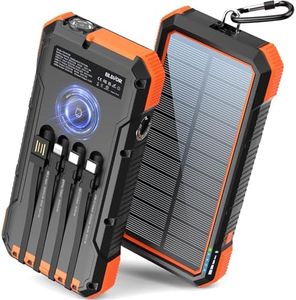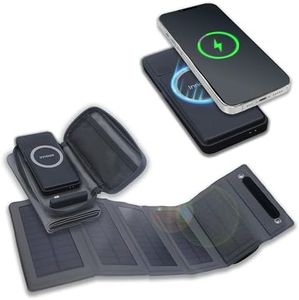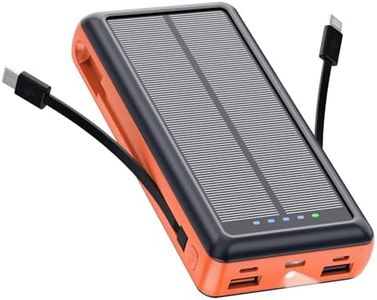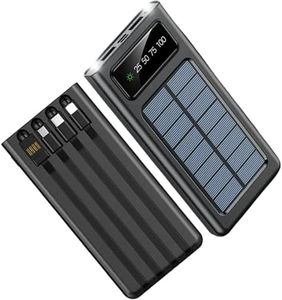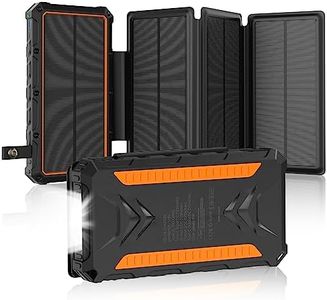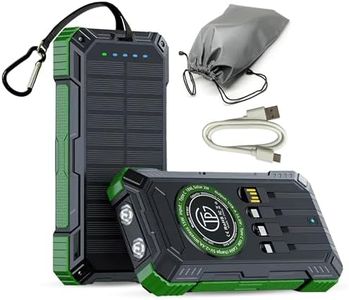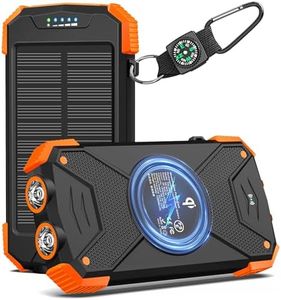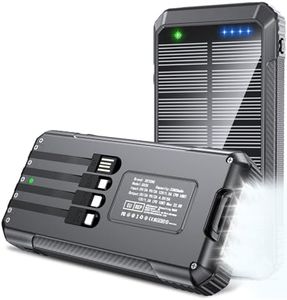We Use CookiesWe use cookies to enhance the security, performance,
functionality and for analytical and promotional activities. By continuing to browse this site you
are agreeing to our privacy policy
10 Best Solar Power Banks
From leading brands and best sellers available on the web.Buying Guide for the Best Solar Power Banks
Choosing a solar power bank can offer you the freedom to charge your devices while on the go or away from electrical outlets, making them great for camping, travel, or emergencies. The right one for you depends on how and where you plan to use it. It's helpful to understand the main features so you can decide what combination of size, charging speed, and durability best fits your lifestyle.Battery Capacity (mAh)Battery capacity, usually measured in milliamp-hours (mAh), tells you how much energy the power bank can store. This directly affects how many times you can charge your device before the power bank needs recharging itself. Lower capacity models (under 10,000 mAh) are usually lighter and smaller, but may only provide one or two charges for a typical smartphone. Mid-range (10,000 to 20,000 mAh) can offer several charges for phones or a couple for tablets. High capacity (over 20,000 mAh) options may be bulkier, but are excellent for longer trips or charging bigger devices like tablets or cameras. To choose, consider how dependent you are on your devices and how often you'll have access to other charging sources.
Solar Panel Size and EfficiencyThe solar panels on these devices convert sunlight into energy to charge the internal battery. Larger panels or those made with high-efficiency materials can harness sunlight more effectively and recharge the bank faster. Small, single-panel models are compact and easy to carry but recharge slowly in the sun, making them better as emergency top-ups. Larger, foldable panels provide faster solar charging and are better suited for outdoor adventures and situations where you'll rely heavily on solar power. Think about how much direct sunlight you expect and how often you'll be outside to benefit from this feature.
Number and Type of Output PortsThe output ports determine how many devices you can charge at once and which devices are compatible. Some power banks have just one USB port, while others may have multiple ports including USB-C or even built-in cables. Single-port devices keep things simple for one device, but if you want to charge multiple phones, a smartwatch, or a headlamp simultaneously, look for more ports or a mix of port types. Consider your devices and whether you'll need to share the charger with others.
Charging Speed (Output Power)Charging speed, indicated in watts (W) or amps (A), affects how quickly your devices are recharged. Lower output power (around 5W/1A) is fine for basic phones, but for faster charging of modern smartphones, tablets, or more power-hungry devices, look for higher output (up to 18W or more, often marked as 'fast charge'). If quick top-ups are important to you, or you have newer devices, opt for a power bank that supports higher output.
Durability and Waterproof RatingDurability measures how well the power bank stands up to daily wear or accidental drops, while waterproof or water-resistant ratings indicate its suitability for outdoor use. Rugged models may have shockproof edges and rubberized casings, and if labeled IPX4, IPX5 or higher, can resist splashes or brief submersion. If you're mostly around town, basic models work fine, but for hiking, camping, or travel, look for one built to withstand tougher conditions.
Weight and PortabilityWeight and size are all about how easy it is to carry the solar power bank. Lighter, pocket-sized models are easy to take everywhere but often store less energy. Larger models give you more capacity and better solar potential, but may be heavier or require backpack space. Think about your typical day and how much carrying extra weight matters.
Extra FeaturesSome solar power banks offer extra features such as built-in flashlights, wireless charging pads, or even compasses. While these can be useful for outdoor activities or emergencies, they are not essential for everyone. Decide if features like these align with your daily routine or travel needs, or if you'd rather keep things simple.

